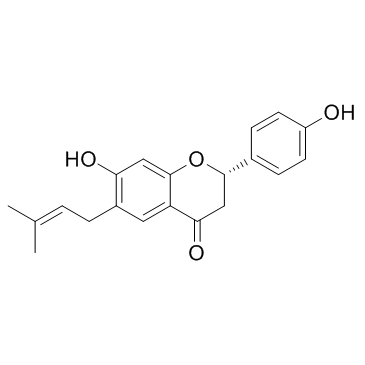19879-32-4
| Name | 7-hydroxy-2-(4-hydroxyphenyl)-6-(3-methylbut-2-enyl)-2,3-dihydrochromen-4-one |
|---|---|
| Synonyms |
4H-1-Benzopyran-4-one, 2,3-dihydro-7-hydroxy-2-(4-hydroxyphenyl)-6-(3-methyl-2-buten-1-yl)-, (2S)-
(2S)-7-Hydroxy-2-(4-hydroxyphenyl)-6-(3-methyl-2-buten-1-yl)-2,3-dihydro-4H-chromen-4-one 7-Hydroxy-2-(4-hydroxyphenyl)-6-(3-methylbut-2-en-1-yl)-2,3-dihydro-4H-chromen-4-one 7-Hydroxy-2-(4-hydroxyphenyl)-6-(3-methyl-2-buten-1-yl)-2,3-dihydro-4H-chromen-4-one 4H-1-Benzopyran-4-one, 2,3-dihydro-7-hydroxy-2-(4-hydroxyphenyl)-6-(3-methyl-2-buten-1-yl)- Bavachin |
| Description | Bavachin, a flavonoid first isolated from seeds of P. corylifolia, acts as a phytoestrogen that activates the estrogen receptors ERα and ERβ with EC50s of 320 and 680 nM, respectively. |
|---|---|
| Related Catalog | |
| Target |
IC50: 320 nM (ERα), 680 nM (ERβ) |
| In Vitro | Bavachin significantly inhibits melanin synthesis and TYR activity. Bavachin (10 µM) inhibits the expression of TYR and JNK proteins, and the expression of TYR, TRP-1, TRP-2, ERK1, ERK2 and JNK2 mRNA in A375 cells. ICI182780 and U0126 cAN significantly reverse the bavachin treatment on the protein expression levels and the mRNA expression of TYR, TRP-1, TRP-2, ERK1, ERK2 and JNK2[1]. Bavachin accumulates lipid in a dose dependent manner in ORO staining experiments. Bavachin significantly increases the growth of preadipoctye at 10 µM compared with the control cells in MTT assay. Bavachin also increases BrdU incorporation into newly synthesized DNA during pre-adipocyte proliferation. BrdU incorporation is enhanced by insulin and further enhanced by co-treatment with insulin and bavachin at 2 and 10 µM. Bavachin activates adipogenic factors and increases PPARγ transcriptional activity in differentiated adipocytes. Bavachin enhances insulin-stimulated glucose uptake through GLUT4 translocation via Akt and AMPK pathway[2]. BVN significantly increases both hMAO-A and hMAO-B activities[3]. Bavachin shows ER ligand binding activity in competitive displacement of [3H] E2 from recombinant ER. The estrogenic activity of bavachin is characterized in a transient transfection system using ERα or ERβ and estrogen-responsive luciferase plasmids in CV-1 cells with an EC50 of 320 nM and 680 nM, respectively. Bavachin increases the mRNA levels of estrogen-responsive genes such as pS2 and PR, and decreases the protein level of ERα by proteasomal pathway[4]. |
| Kinase Assay | The chemiluminescent assay is used to confirm PCSEE MAO-A and MAO-B inhibitory effects and to test BNN and BVN hMAO-A and hMAO-B inhibition using MAO-Glo kit. Each enzyme's Arbitrary Light Unit (ALU) is measured in the presence of PCSEE, BNN, BVN, and standard DEP as an MAO-BI positive control. Briefly, hMAO-A and hMAO-B isozymes are diluted to 2× with reaction buffer (pH 7.4) and preincubated with 4× PCSEE, BNN, BVN, or DEP working solutions at RT for 30 min in white opaque 96-well plates. For determining activity inhibition, final 8.5 μg/mL concentrations of PCSEE, BNN, BVN, and DEP are used. For IC50 determination, 8× PCSEE and BNN working solutions are serially diluted using reaction buffers (pH 7.4) to make a 4× concentration. Ten points' range of PCSEE (1.0 to 250.0 μg/mL) and BNN (up to 400 μM (135.4 μg/mL)) final concentrations is used. Controls used are with and without ethanol. Ethanol solvent in controls is kept to a maximum final (volume) of ≤2%. Each isozyme is substituted with the reaction buffer for the blank. Based on our preliminary optimizations and Valley's method, the reaction is initiated by adding 4× luciferin derivative substrate (LDS) for a final (concentration) of 40 and 4 μM for hMAO-A and hMAO-B reactions, respectively. The final volume per well of each reaction is 50 μL. The reaction is optimized for the amount of A and B enzyme used to be incubated for less than 3.5 h at RT. To stop the reaction and produce the luminescence signal RLDR is added to all wells, 50 μL to each well, and incubated for a further 30 min. |
| Cell Assay | MTT solution (20 µL) is added to each well of the 96-well plates, the cells are cultured for 4 h, the solution is discarded, and the purple crystal is dissolved in the wells with 150 µL DMSO solution, agitated in a 37°C incubator shaker for 10 min, and the optical density (OD) is measured at 490 nm by the microplate reader. |
| References |
| Density | 1.2±0.1 g/cm3 |
|---|---|
| Boiling Point | 558.3±50.0 °C at 760 mmHg |
| Molecular Formula | C20H20O4 |
| Molecular Weight | 324.370 |
| Flash Point | 202.1±23.6 °C |
| Exact Mass | 324.136169 |
| PSA | 66.76000 |
| LogP | 4.85 |
| Vapour Pressure | 0.0±1.6 mmHg at 25°C |
| Index of Refraction | 1.622 |
| Storage condition | 2~8°C |
| Hazard Codes | Xi |
|---|


